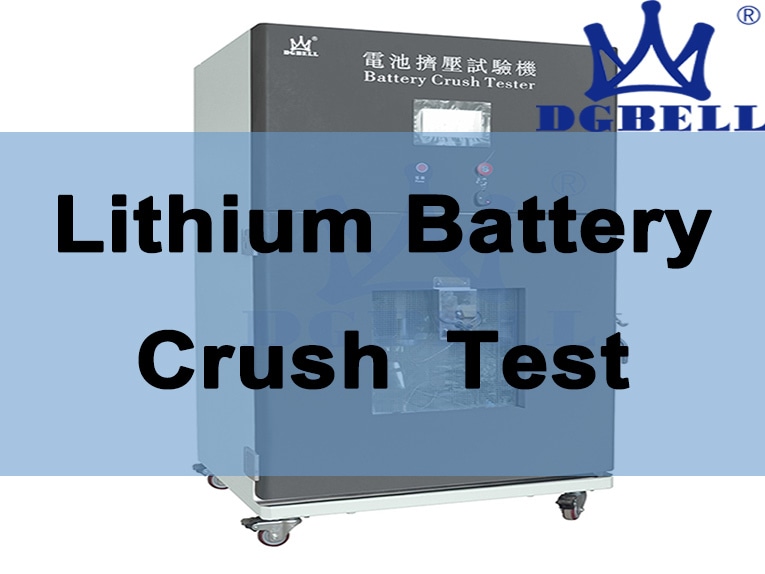
#Industry News
Crush Test for Lithium Battery
Crush Test for Lithium Battery
With the popularization of new energy electric vehicles, the safety issues of electric vehicles are receiving increasing attention. Among them, the safety characteristics of lithium batteries are one of the key factors for the safety of electric vehicles. This article takes ternary soft pack lithium batteries as the research object, and through experimental and simulation research, explores the safety characteristics of lithium batteries under different shapes of crush heads, different crush positions, and different initial state of charge (SOC) conditions.
The research results indicate that the sharper and narrower the shape of the crush head, the earlier the sudden temperature rise time of the lithium battery, the greater the sudden temperature loss, and the higher the internal resistance rise. The closer the squeezing position is to the bottom edge of the lithium battery, the more likely the temperature rise is to cause thermal runaway. The closer the squeezing position is to the pole ear, the greater the capacity loss and internal resistance value. In addition, the higher the SOC of lithium batteries, the more likely they are to experience thermal runaway, greater voltage drop, greater capacity loss, and greater internal resistance.
In order to gain a deeper understanding of the safety characteristics of lithium batteries under different conditions, this article also established thermal and stress simulation models for lithium batteries based on the COMSOL software platform, and conducted simulations of temperature and stress changes of lithium batteries under various crush conditions. The simulation results show that the temperature and deformation patterns of lithium batteries after crush are in good agreement with actual crush experiments.
1 Working principle
When a lithium battery is discharged, electrons flow from the negative electrode to the positive electrode through an external circuit, while lithium ions move from the negative electrode to the positive electrode. During this process, lithium ions are transferred through the electrolyte and pass through the separator to reach the positive electrode. This process is called the lithium removal reaction.
When a lithium battery is charged, electrons flow from the positive electrode to the negative electrode through an external circuit, while lithium ions move from the positive electrode to the negative electrode. During this process, lithium ions are transferred through the electrolyte and pass through the separator to reach the negative electrode. This process is called lithium intercalation reaction.
The thermal runaway of lithium batteries refers to the phenomenon of overheating, ignition, and explosion caused by the rapid change in the rate of self temperature rise of the battery caused by the chain reaction of single cell heat release. This phenomenon may be caused by internal short circuits, overcharging, squeezing, high temperatures, and other reasons in the battery. When the temperature of the battery increases to a certain extent, the internal chemical reaction rate of the battery accelerates, generating a large amount of heat energy, leading to a rapid increase in battery temperature and ultimately leading to thermal runaway of the battery. During this process, the electrolyte inside the battery will decompose, the positive and negative electrode materials will burn, and the battery will catch fire or explode.
Therefore, when using lithium batteries, it is necessary to pay attention to safety issues and avoid adverse operations such as overcharging, discharging, squeezing, and high temperature to ensure the safety and stability of the battery. At the same time, during use, the condition of the battery should be regularly checked, and problems should be identified and dealt with in a timely manner to avoid safety accidents.
2 Lithium battery crush
The existing research objects mainly include square shell lithium iron phosphate batteries and 18650 cylindrical lithium batteries. There are two main research methods: experimental research and simulated straight research. In experimental research, there are three main mechanical loading methods for cylindrical lithium batteries: three-point bending method, axial radial crush method, and local crush method; The main mechanical loading methods for square lithium batteries are local crush method and flat plate crush method. The main shapes of crush heads are flat, spherical, hemispherical, and conical.
3 Test chamber
Lithium battery crush test chamber
Capable of providing crush states under different conditions while recording changes in battery safety characteristics. This device typically includes a compression device, data acquisition system, safety protection device, and other components. In the experiment, researchers used a squeezing experimental platform to squeeze lithium batteries with different shapes, forces, and positions to analyze the changes in safety characteristics of lithium batteries under various conditions. The data collection system will collect real-time safety characteristic parameters such as temperature, voltage, internal resistance, and capacity of lithium batteries to help researchers understand the changes in lithium batteries during the crush process. The safety protection device is used to protect the safety of personnel and equipment during the experimental process.
Parameter acquisition system
The collection system includes a temperature collection system, a voltage collection system, a resistance collection system, and a battery capacity collection system. Among them, the temperature acquisition system uses K-type thermocouples and an 8-channel temperature data acquisition module to transmit data to the upper computer through RS485 to USB. The voltage acquisition system uses a voltage transformer for signal transformation and transmits data to the upper computer through RS485 to USB; The resistance acquisition system uses the resistance voltage division method for signal transformation, and transmits data to the upper computer through RS485 to USB; The battery capacity collection system uses a potassium battery capacity tester for testing and transmits the test results to the upper computer. The entire collection system achieves data collection and transmission through a data collection module, and ultimately displays and analyzes it on the upper computer.
4 Conclusion
Different initial SOC crush experimental results:
(1) The effect of different initial SOC on the appearance of lithium batteries is not significant.
(2) The safety characteristic parameters of lithium batteries with different initial SOC vary after crush.
(3) The 100% SOC lithium battery has a thicker thickness at the crush point.
Experimental results of crush with different shapes of crush heads:
(1) The right angle crush head produces a larger crush area for lithium batteries, and the crush position is relatively narrow.
(2) The cylindrical crush head produces a smaller crush area for lithium batteries, and the crush position is relatively blunt.
(3) Under the same initial SOC and crush position conditions, the safety characteristics of lithium batteries with two different shapes of crush heads are as follows:
The influence of numbers varies.






